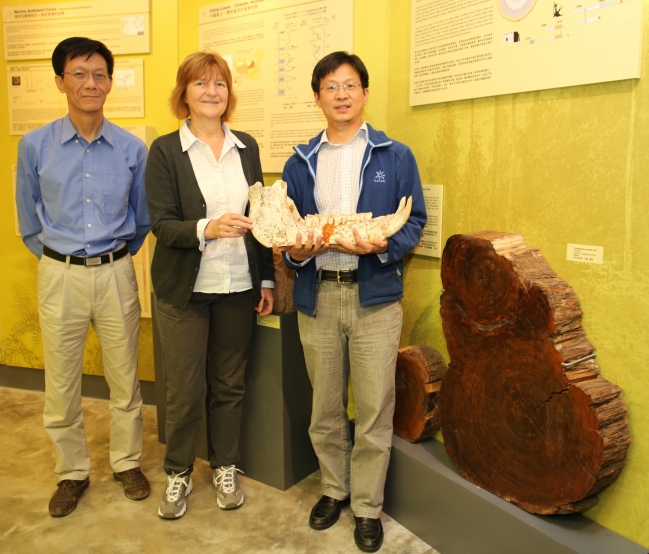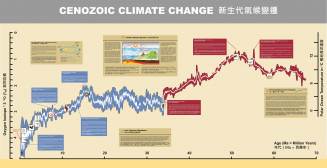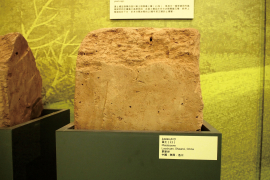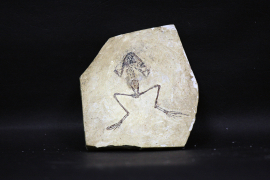Media
An HKU exhibition to launch on Earth Day to showcase the last 65 million years of Climate Change unfolding lessons for forseeing our future
21 Apr 2015
Curator of HKU Stephen Hui Geological Museum Dr. Petra Bach and two climate change experts of the Department of Earth Sciences Dr. Liu Zhonghui (right) and Professor Zong Yongqiang (left) explain the research behind the “Cenozoic Climate Change” exhibition through displaying ancient tree rings, ancient rhinoceros paradise fossil and other exhibits.
The Stephen Hui Geological Museum of the University of Hong Kong (HKU) will launch a new permanent exhibition on “Cenozoic Climate Change” on Earth Day (tomorrow, April 22, 2015). The Cenozoic Era is the most recent geological period which spans from about 65 million years ago (Ma) to present. The Cenozoic is sometimes called the Age of Mammals because the extinction of dinosaurs at the beginning of the Cenozoic allowed mammals to greatly diversify and grow in size during this time. A media tour was held today (April 21, 2015) with the curator of the Museum Dr. Petra Bach and two climate change experts of the HKU Department of Earth Sciences Dr. Liu Zhonghui and Professor Zong Yongqiang joined the briefing to explain the research behind.
Paleoclimate proxies including marine sediments, loess, tree rings and marine microorganisms are displayed together with an ice core replica for the first time in Hong Kong to introduce scientific methods applied to read past global and regional climate records and to reconstruct the last 65 million years of global climate change.
Through the study and analysis of such information, scientists hope to gain more understanding of the relationship between past and future climates and on how human activity might impact climate change in the future.
Highlights on display:
The 2x10m long display comprises themes such as Clues to Past Climates, From Greenhouse to Icehouse and Human Impact supplemented with authentic fossils from world renowned fossil sites in China.
A large-scale 3-D climate change graph
The graph demonstrate the most widely accepted and scientifically cited evidence for global climate change during the last 65 million years of Earth history based on stable oxygen isotope records derived from marine microorganisms. It invites to explore and reflect on the relationship of our present-day climate conditions with that of the past.
Hong Kong marine core
A preserved segment of an originally soft marine sediment core sampled from the northwest coast of Lantau Island in Hong Kong contains two sections of marine sediment showing the changes in sea level. The lower section was deposited in the last interglacial about 125,000 years ago, when the sea level was a few meters higher than the present and the sea water temperature was about 2°C warmer. Followed by a glacial period, sea level decreased so that the lower layer was exposed to air and oxidized to a yellowish colour. Records of the glacial period between the two layers are missing as sea levels then were too low for any marine sediment to be deposited. The upper section was deposited during the past 7000 years, i.e. the current interglacial.
Ancient tree ring from the Pearl River Delta
A 3000 years old fossil wood of a pine tree (Glyptostrobus pensilis) from the Pearl River Delta was once part of an ancient forest that flourished under wet and humid climate until environmental conditions abruptly changed causing the ancient forest to be quickly buried and airproofed, so preserving the wood in good conditions for thousands of years. Tree rings of such ancient wood reveal past climatic conditions.
Glyptostrobus pensilis
Pinophyta
3000 B.P., Guangdong, China
China Loess – climate records written in dust
A loess sample is a windblown dust deposit from the Central China Loess Plateau with a thickness about 500 metres. It was formed at the beginning of the last glacial period around 100,000 years ago when cold and dry winter monsoon winds transported dust from the deserts in northern and western China and deposited it in central China. During interglacial periods, such as the current one Holocene, paleosol layers were formed. A continuous deposit of such loess and paleosol layers reveals periodical climatic cycles during the last 2.6 million years.
Loess (L1)
Pleistocene
Luochuan, Shaanxi, China
Fossil from an ancient rhinoceros paradise in Linxia basin, north of the Tibetan Plateau
Rhinoceroses and other large mammals thrived in a warm steppe environment of the ancient Linxia basin during late Miocene period approximately 5-10 million years ago until a strong uplift of the Tibetan Plateau caused a stronger monsoon system with an overall dryer and cooler climate reducing the diversity of the mammals and leading to the extinction of Rhinoceroses in this area.
Chilotherium wimani (Rhino mandible)
Mammalia, Perissodactyla, Rhinocerotidae
Miocene, Linxia Basin, Gansu, China
Fossils from the Shanwang Biota in Eastern China
Well preserved 17 million year old frog, fish and leaf fossils represent the ancient Shanwang Biota found in eastern China. They reveal an incredibly rich biodiversity of a Cenozoic terrestrial ecosystem of a lake environment during the warmest period in the last 25 million years of the Earth history, the so-called Mid Miocene Climatic Optimum with temperatures that were 3-6°C higher than today.
Rana Basaltica
Amphibia Anura
Miocene, Shandong, China
Liquidambar miosinica
Angiospermae, Magnoliopsida, Hamamelidales
Miocene, Shandong, China
Lessons to be learned:
-
Climate has changed many times and in many different ways over the last 65 million years
The results reveal two patterns of climate change (1). a continuous long-term climate change from warm conditions with up to 15°C higher surface temperatures and ice-free poles 65 million years ago changing to cooler conditions with the present-day polar ice caps; and (2). short-term climate changes which are comprised of important short-term periodical as well as abrupt climate variations in the past. -
Abrupt climate changes
The Cenozoic past reveals important short-term abrupt climate variations when temperature and CO2 levels jumped rapidly which were highly disruptive and sometimes caused extinctions. Earth scientists try to understand the forcing mechanism that contribute to such rapid warming in the Earth’s past under conditions with similar continent configuration, paleogeography and ocean circulations contributing to improved climate change forecasts for our future. -
A break in the pattern
Different paleoproxy data all have been in tune with the global changes of the Pleistocene glacial and interglacial cycles following a periodicity of 100,000 years revealing a cyclic pattern with constant variations of 100ppm CO2 until the beginning of the Industrial Revolution 1730. From that time atmospheric CO2 levels rose from 280ppm to 400ppm today in only 300 years exceeding by far the natural range of the last 650,000 years. -
Another abrupt Climate change?
Human activity is increasing concentrations of greenhouse gases in an extent that it raises concern that the climate could respond in an abrupt and unexpected way. What makes the current situation unpredictable is that never before has CO2 climbed so fast and so high during an interglacial period, causing an abrupt climate change that may take place so rapidly that humans and all natural systems may have difficulties adapting to it.
This exhibition is part of HKU’s Knowledge Exchange effort making recently conducted climate research at the Department of Earth Sciences accessible to the public.
Exhibition details:
Venue: Stephen Hui Geological Museum, G/F and 1/F, James Lee Science Building, HKU, Pokfulam
Opening Hours:
Monday to Friday, 1pm to 6pm
Closed on University and Public Holidays.
Free Admission
Special Guided Tours on Climate Change:
Available in English or Cantonese on four Saturdays, April 25. May 2, 9 and 16 at 2-3pm with opening hours from 10am to 6pm.
Pre-registration through Tel: 22415472 or e-mail at http://www.earthsciences.hku.hk/shmuseum/ is recommended.
General Enquiry: 2241 5472 or e-mail: shmuseum@hkucc.hku.hk
Media enquiries:
HKU Communications & Public Affairs Office Ms Rhea Leung (Tel: 2857 8555 / 9022 7446/ Email: rhea.leung@hku.hk) or HKU Stephen Hui Geological Museum Dr. Haz Cheung (Tel: 2241 5472/ Email﹕hmcc@hku.hk)







